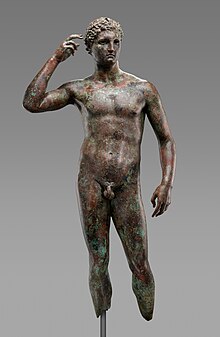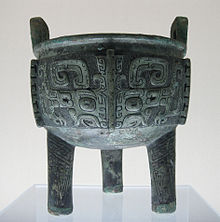
Back Bronzeskulptur Danish Bronzeplastik German Bronza skulptaĵo Esperanto Escultura en bronce Spanish مجسمه برنزی Persian Sculpture en bronze French कांस्य कला Hindi 銅像 Japanese 동상 (형상) Korean Bronze (escultura) Portuguese





Bronze is the most popular metal for cast metal sculptures; a cast bronze sculpture is often called simply "a bronze". It can be used for statues, singly or in groups, reliefs, and small statuettes and figurines, as well as bronze elements to be fitted to other objects such as furniture. It is often gilded to give gilt-bronze or ormolu.
Common bronze alloys have the unusual and desirable property of expanding slightly just before they set, thus filling the finest details of a mould. Then, as the bronze cools, it shrinks a little, making it easier to separate from the mould.[1] Their strength and ductility (lack of brittleness) is an advantage when figures in action poses are to be created, especially when compared to various ceramic or stone materials (such as marble sculpture). These qualities allow the creation of extended figures, as in Jeté, or figures that have small cross sections in their support, such as the equestrian statue of Richard the Lionheart.[2]
But the value of the bronze for uses other than making statues is disadvantageous to the preservation of sculptures; few large ancient bronzes have survived, as many were melted down to make weapons or ammunition in times of war or to create new sculptures commemorating the victors, while far more stone and ceramic works have come through the centuries, even if only in fragments. As recently as 2007 several life sized bronze sculptures by John Waddell were stolen, probably due to the value of the metal after the work has been melted.[3]
- ^ Savage, George (1968). A Concise History of Bronzes. New York: Praeger. p. 17. OCLC 593861928.
- ^ Hornbostel, Caleb (1991). Construction Materials: Types, Uses and Applications (Second ed.). New York: John Wiley & Sons. p. 175. ISBN 9780471851455.
- ^ "Article: Beauty and the Beast in Cornville Arizona". April 2007. Archived from the original on 2012-03-24. Retrieved 2011-05-19.